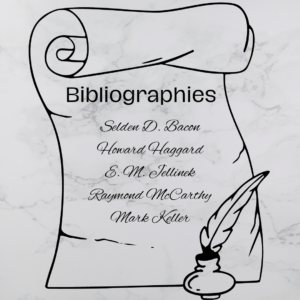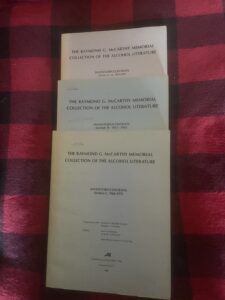 What’s the point of spending countless hours digging up old books and journals to compile a list of publications by scholars no longer with us?
What’s the point of spending countless hours digging up old books and journals to compile a list of publications by scholars no longer with us?
About publication lists
In general, a publication list is meant to document one’s scholarly and professional activities, to be attached to their CV when applying for a job, a grant, tenure, or promotion. It’s a dynamic and evolving list, and keeping it current is in the scholar’s best interest. Nowadays, it is fairly easy to collect citations from various databases, whether for journal articles, books, book chapters, or conference proceedings. It’s even easier to store all the information in one of the popular citation management software applications, such as EndNote, RefWorks, or Zotero. Librarians and researchers generally recommend creating a “My Publications” folder in one’s favorite citation management system and watching it grow.
However, when it comes to pulling together all publications of an accomplished scholar to develop their comprehensive author bibliography, the process is much more complicated. Each record has to be (painfully) verified, with the item in hand at best, or with the help of a PDF downloaded or scanned upon request after discovering and locating the item from various sources. The workflow looks simple if the researcher has a skeleton bibliography to start with: one already compiled for a CV or in a Festschrift, which is a volume of texts written by close colleagues to honor the scholar and also contains a decent bibliography of their works.
The purpose of creating these bibliographies
We believe in looking back into the past for inspiration, guidance, wisdom, and any other advice that can be gained from investigating how research was conducted and published. Interpreting these bibliographies will contribute to a better understanding of our present research agenda and help us create a more meaningful career path for our contemporary researchers. There’s nothing new under the sun, says the adage. While this may not be one hundred percent true, there’s still a lot to learn from past experiences, including the rich scholarly output of researchers in our field.
The process: Compiling a historical bibliography in alcohol studies
As authors of several published comprehensive bibliographies, we have some insight into this process, including its roadblocks and best practices. We often got lucky and located a list to start with. However, even if one has an initial list, each record has to be individually verified. For scholars in our field, especially for those who laid the foundations of modern-day alcohol studies, there is a great resource to help with over forty years of data.
 The Raymond G. McCarthy Memorial Collection at the Rutgers Center of Alcohol Studies Library features three volumes of cumulative bibliographies in three volumes of its inventory: Section A (cca. 1935-1950), Section B (1951-1965), and Section C (1966-1976). The original idea came from Mark Keller, editor of QJSA, and Selden D. Bacon, director of CAS, to gather the full-text originals of all publications abstracted and indexed in the Classified Abstract Archive of the Alcohol Literature and the QJSA and name the collection after Raymond G. McCarthy, the director of the Rutgers Summer School of Alcohol Studies.
The Raymond G. McCarthy Memorial Collection at the Rutgers Center of Alcohol Studies Library features three volumes of cumulative bibliographies in three volumes of its inventory: Section A (cca. 1935-1950), Section B (1951-1965), and Section C (1966-1976). The original idea came from Mark Keller, editor of QJSA, and Selden D. Bacon, director of CAS, to gather the full-text originals of all publications abstracted and indexed in the Classified Abstract Archive of the Alcohol Literature and the QJSA and name the collection after Raymond G. McCarthy, the director of the Rutgers Summer School of Alcohol Studies.
The three volumes contain records of all items that have the full text of the respective articles or book actors in the collection. Needless to say, with its 428 file boxes, this collection is huge and hasn’t been digitized. A microform version, still in boxes, is also waiting for a generous benefactor who would sponsor such a large-scale project. Until then, all print materials will remain in their respective red boxes emblazoned with ”The Raymond G. McCarthy Collection” in gold in the Rutgers University Libraries Annex. The records are also available in the card catalog at the same location, organized alphabetically by author. Multiple publications by the same author are arranged chronologically, and co-authors are also listed, with reference to the first author, just like in the inventory volumes.

The McCarthy Collection was relocated to the Rutgers University Libraries Annex in 2017
Read parts 1-3: Author bibliographies in alcohol studies
Published author bibliographies (with introductory articles)
- Ward, J. H., & Bejarano, W. (2016). A tribute to Bunky at 125: A comprehensive bibliography of E. M. Jellinek’s publications.Journal of Studies on Alcohol and Drugs, 77, 371–374.
- Allred, N., Bejarano, W., & Ward, J. (2017). Howard Wilcox Haggard and the Institutionalization of Modern Alcohol Studies. Journal of Studies on Alcohol and Drugs, 78(2), 325-329.
- Allred, N., Bejarano, W., & Ward, J. H. (2023). A Sociologist and the Problems of Alcohol Studies: The Life and Legacy of Selden D. Bacon. Journal of Studies on Alcohol and Drugs, 84(5), 791–796.